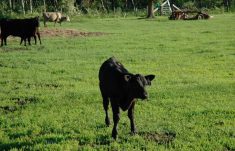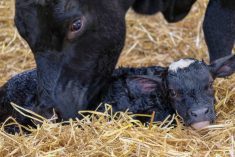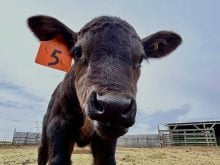Last year, I asked a friend who operates a 400-Simmental x Angus beef cow operation about his No. 1 goal, after all his cows dropped their calves by the end of April.
He replied that all his mature and young cows should show a couple of strong heats before they are let out with the bulls. He then implements a high plain of nutrition from post-partum until the breeding season; he calls it “reproduction planning.”
Its success assures all of his fertile cows are in good shape — inside and out — for breeding and conception. An open cow, to him, is a financial liability and not given a second chance.
Read Also

Gentle treatments for pain in the neck
Heading toward year-end, people unknowingly tense up against the cold and busyness, causing neck pain that can often be treated with appropriate support and gentle mobility, athletic therapist Kathlyn Hossack says.
His post-calving nutrition dovetails with well-balanced overwinter feeding programs. Their specific dietary foundation is based on the overall energy status of his nursing beef cows, which is the largest and first-limiting nutrient.
He correctly believes it affects his cow herd fertility the most. The actual energy requirement is very low for reproductive activities such as follicular growth, ovulation and early embryonic development, and that takes on a very low priority compared to energy needs for body maintenance and milk production.
Luckily, my friend determines each cow’s energy status (with good fertility) by assessing the animal’s body condition score (BCS, on a scale of 1 = emaciated to 9 = extremely obese). Post-partum beef cows and heifers should maintain a BCS of 5-6 by calving, which should be carried to the end of the upcoming breeding season. Such adequate BCS returns a higher proportion of fertile beef cows compared to thin cows (BCS lower than 4) to a strong estrus 80-90 days post-partum, which ends in high conception rates. The next year’s calves are often born earlier in a desired short calving season, which also results in higher — as much as 50-60 lbs., I’ve seen — autumn weaning weights.
Several university studies have confirmed my friend’s commitment of maintaining BCS from calving to the breeding season. Case in point: a two-year Oklahoma State University study illustrates two polarized BCS situations: beef cows that were fed to maintain body condition from calving until the beginning of the breeding season averaged 94 per cent pregnant, while those that calved in similar body condition but lost nearly a full condition score were 73 per cent rebred.
As a beef nutritionist, I have built my friend’s post-partum cow diets on supplying fresh beef cows with a BCS of 5-6, producing 10-15 litres of milk for their calves with about 58-62 per cent dietary TDN (total digestible nutrients) and about 11-12 per cent protein, to maintain such good body condition until the breeding season.
Given that a mature gestating beef cow (500-600 kg) consumes about 2.25-2.5 per cent of her body weight (dry matter basis), I suspect they will consume about 12-14 kg of dry-based feed, daily.
Menu options
Here are my friend’s three feeding options, to be fed in drylot until his nursing cows are let out on sprouting green pastures in order to be rebred by the resident bulls. It should be noted most of these diets are based on medium- to high-quality forages (avoiding low-quality straw) with relatively little concentrate being offered unless the weather dips below –20 C. Then, one to 1.5 kg more grain/screening pellets are added to each diet, below:
- 15 kg mixed alfalfa-grass baleage, seven kg of crested wheatgrass hay, one kg of barley (optional) and 100 grams of a 1:1 cattle breeder mineral.
- 20 kg of barley silage, five kg of canola/grass hay, one kg of DDGS (added for protein), and 100 grams of a 2:1 cattle breeder mineral.
- 10 kg of barley silage, 10 kg of first cut alfalfa hay and 1.5 kg of a 14 per cent screening pellet with minerals/vitamins.
As a footnote to these well-balanced post-partum diets, a strong mineral/vitamin feeding program is also implemented. It contains fortified levels of calcium and phosphorus as well as copper and zinc in bio-available “chelated forms.” Extra vitamin A and E are also formulated.
Following such reproduction planning after calving, and until the breeding season, returns my friend’s cowherd to active heat cycles on cue.
From this success it follows that most of his cows are rebred within a few weeks of an established annual 60-day breeding season. It’s therefore a big contributor to his herd achieving a 96 per cent calving rate almost every year, with only a handful of cows shipped away due to infertility.
















